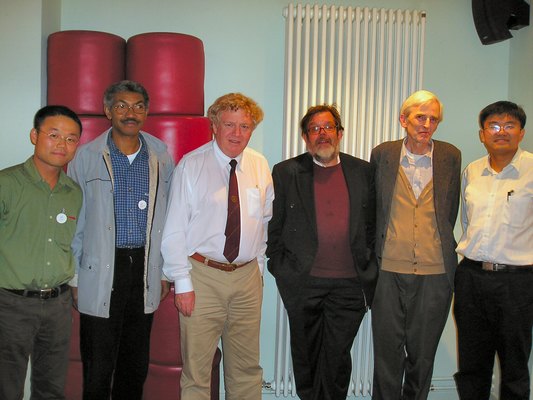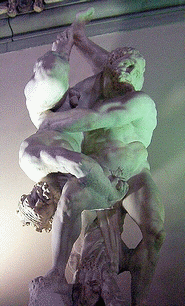
 |
Edinburgh, Scotland, United Kingdom, 28-30 August 2007: First Annual Conference of the International Association for Comparative Mythology, under the title ‘The Deep History of Stories’; convenors Emily Lyle for The Traditional Cosmology Society, Edinburgh, and Michael Witzel for the International Association for Comparative Mythology. |
homepage Ancient Models | Topicalities page | Shikanda portal
 |
The International Association for Comparative Mythology was informally founded during the Beijing / Harvard conference on Comparative Mythology, Peking University, Beijing, 2006. It seeks to formalise and perpetuate the focus on Comparative Mythology which emerged from c. 2000 in a series of Annual Conferences initiated by Michael Witzel (Department of Asian and Sanskrit Studies, Harvard University, Cambridge Mass.) and known as Harvard Round Tables. The Association runs a Yahoo discussion group 'compmyth'. From its inception, its secretariat has been in the capable hands of Prof. Boris Oguibenine, Strassburg University, France. At Edinburgh, 2007, the Association was formalised by the decision to seek registration at Boston (Mass.) under USA law, by electing a formal executive (including the site owner as one of its members), and by agreeing on a membership fee. Further details discussed were a journal as official organ of the International Association for Comparative Mythology, and the place and time for the Second Annual Conference. In Beijing 2006, Wim van Binsbergen (Leiden / Rotterdam) and Eric Venbrux (Nijmegen) had already proposed to jointly convene the 2008 Annual Conference, and in Edinburgh they presented a detailed plan to this effect. |
| Discussing Austronesian mythologies and their genetic basis at Pollock Hall, Edinburgh University were, from left to right: H. Yamadah (Japan), Michel Razafiarivony (Madagascar), Stephen Oppenheimer (United Kingdom), Wim van Binsbergen (Netherlands), Michael Witzel (United States) and Shi Yang (People's Republic China) (photo Kas Matsumoto, Japan) |
At the First Annual Conference of the International Association for Comparative Mythology, under the title ‘The Deep History of Stories’; convenors Emily Lyle for The Traditional Cosmology Society, Edinburgh, and Michael Witzel for the International Association for Comparative Mythology, Wim van Binsbergen presented a paper under the title:
| ABSTRACT. The paper is devoted to the Sunda thesis as launched by the leading British geneticist Stephen Oppenheimer in 1998. Largely concurring with Oppenheimer, but against the background of an explicitly theoretical position and critical of Oppenheimer's archaeology and Frazerianism, the paper extensively states the positive case in favour of the generalised Sunda thesis, on the basis of additional African and European material (from comparative mythology, comparative ethnography, ancient history and comparative linguistics) not yet adduced by Oppenheimer. However, the argument is critical of the specific application of the Sunda thesis in the field of comparative mythology. Although there are several indications that mythical themes already circulating in the Old World for tens of thousands of years where transformed / innovated and subsequently spread in the Sunda context, multivariate analysis (upon a contents analysis of a representative corpus of flood myths from all over the world, graciously made available by Marc Isaak) brings out that this is not the case for the Nuahite (Noah-related) type of flood myth, centring on 'The flood hero in his ark as an ally of the Supreme God' -- as exemplary for the core mythologies of the Ancient Near East and of the Bible. Far from being the source of Western civilisation, as Oppenheimer claims, Sunda turns out to be a relatively recent recycling context (7 ka BP, on a total time scale of 200 ka for Anatomically Modern Humans), which however in recent millennia has been a major source of non-demic cultural diffusion all over Oceania; South, East and Southwest Asia; Africa; and probably even parts of Europe. Whilst thus assessing and to a considerable extent vindicating Oppenheimer's seminal thesis, the paper also entails the specific presentation and of a more comprehensive theory as an attractive alternative to Oppenheimer's: Wim van Binsbergen's own 'Aggregative diachronic approach to world mythology, starting from the African continent'. The latter theory was the subject of Wim van Binsbergen's contributions to the Harvard Round Table on Comparative Mythology during its 2005 and 2006 sessions at Kyoto (Japan) and Beijing (People's Republic of China) respectively. |
Thus the Edinburgh 2007 paper partly covers the same ground as the site owner's Introduction to the Sunda thesis, presented earlier in August 2007 at a Seminar on Sunda culture at the Centre for Cultural and Religious Studies (CCRS), Department of Philosophy, Parahyangan Catholic University, Bandung, Indonesia ( van Binsbergen, Wim M.J., 2007, 'Introduction to the Sunda thesis: Claiming extensive pre- and proto-historic cultural influence from Indonesia upon South and West Asia, the Ancient Near East, and by extension upon Africa and Europe', Seminar, Centre for Cultural and Religious Studies (CCRS), Department of Philosophy, Parahyangan Catholic University, Bandung, Indonesia, August 4, 2007 (click for Powerpoint presentation) .
The paper benefitted greatly from the latter's pre-conference feedback and from his personal comments during the session at which when it was presented.
| The presentation of this paper at the First Annual Conference of the International Association for Comparative Mythology, and its positive reception especially by Stephen Oppenheimer whose work it is constructively assessing, marks the coming of age of the over-ambitious theory which has been at the centre of the site owner's research since 2005. Being an exercise in interdisciplinary method and analysis, at the intersection of genetics, archaeology, linguistics, comparative mythology and comparative ethnography (especially of Africa), it was the genetics that was furthest from his professional field of competence -- it is over forty years since he formally read some human biology (then called physical anthropology) under Rudolf Bergman at Amsterdam University. What one fears most in interdisciplinary borrowing, is that the borrowed knowledge is stale and that one has moreover totally misunderstood and misrepresented it. Engaging in critical debate with one of Britain's leading geneticists, and in the process not only being spared public disgrace but even parting as friends and perhaps prospective collaborators, means that the long and frustrating process of finding a suitable general paradigm for my long-range approaches sinds the 1990s, is finally coming to an end. The site owner's several books in draft can now be at long last be finalised and published. |  |
Antaeus and Hercules (Anteo et Ercole) in combat (Palazzo Vecchio, Florence). Note the modern application of the combat myth to the present debate between Stephen Oppenheimer and Wim van Binsbergen – even though the conference participants had to be disappointed in the sense that the combat remained purely academic and unbloody, and – cf. the combat between Gilgamesh and Enkidu – soon made way for the joint pursuit of a common goal – to put the general Sunda thesis on the map, and continue to explore its specific application to myths. |
Meanwhile the original Powerpoint Presentation as presented at Edinbrugh, 2007, had now been worked into a article, currently in the press in the journal Cosmos: Journal of Ancient Cosmology (Univ. of Edinburgh); click here for a pre-print (PDF): Wim van Binsbergen, in press (2008), 'Transcontinental mythological patterns in prehistory: A multivariate contents analysis of flood myths worldwide challenges Oppenheimer’s claim that the core mythologies of the Ancient Near East and the Bible originate from early Holocene South East Asia':
| ABSTRACT. The present argument is devoted to the Sunda thesis, launched by the leading British geneticist Stephen Oppenheimer in 1998. He made two claims: (1) there was decisive Indonesian / Sundaland prehistoric cultural influence on West Asia (the General Sunda Thesis); (2) this influence is specifically manifest in the core mythologies of the Ancient Near East and the Bible (the Special Sunda Thesis). Van Binsbergen’s Aggregative Diachronic Model of Global Mythology, which is briefly introduced, suggests that many of the mythical themes for which Oppenheimer claims a unique Sunda origin, have a much older history elsewhere in the Old World. These themes may have undergone major transformations and innovations, in the Sunda context, and may have subsequently spread to Oceania and the western half of the Old World, in that context. The Nuah?ic (Noah-related) type of ‘Elaborate’ Flood Myth, centring on ‘The flood hero in his ark as an ally of the Supreme God’, is taken to be exemplary for the core mythologies of the Ancient Near East and of the Bible addressed in Oppenheimer’s Special Sunda Thesis. However, multivariate analysis (upon a contents analysis of a representative corpus of flood myths from all over the world), far from massively and unequivocally confirming Oppenheimer’s Special Sunda Thesis, merely makes plausible that for a minority of mythemic traits found in flood myths worldwide, a Sunda effect may be claimed, not for the origin of that trait, but for relatively minor aspects of its subsequent distribution. One multivariate analysis was based on discriminant analysis, another on factor analysis; both bring out that – pace Oppenheimer – most probably, and in line with conventional views, the mytheme of ‘The flood hero in his ark as an ally of the Supreme God’ originated in that form in Central Asia, and from there spread worldwide, also to Sundaland, from where sometimes a further spread with Sunda effect may be reconstructed. Far from being the source of Western, subsequently global, civilisation, as Oppenheimer claims, Sunda turns out to have been mainly a relatively recent recycling context. These statistical analyses unexpectedly highlight the possible role of the New World in the intercontinental prehistory of flood myths. They further demonstrate that the Nuah?ic mytheme is in itself composite; one or two of its twelve principal components could perhaps have originated in South East Asia or have been intercontinentally transmitted via that region from a New World origin. |
homepage Ancient Models | Topicalities page | Shikanda portal
| page last modified: 07-09-08 16:38:44 |  |
 |
|||